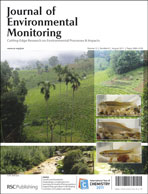Sources and fate of Salmonella and fecal indicator bacteria in an urban creek
Abstract
This research aimed to understand the sources and fate of Salmonella and fecal bacteria in urban surface waters. An urban creek (San Pedro Creek, California, USA) that had unusually high levels of Salmonella and fecal bacteria relative to other nearby waterbodies was chosen as a model field site. State of the art microbiological methods were used in concert with modeling to investigate Salmonella and fecal bacteria sources, and determine field-relevant dark inactivation and photoinactivation rates. Three along-creek surveys that spanned reaches adjacent to both urban and forested land covers were conducted to measure Salmonella, enterococci, Escherichia coli, and horse- and human-specific Bacteroidales. Salmonella were detected adjacent to and downstream of urban land cover, but not adjacent to forested land cover. No human or horse-specific Bacteroidales fecal markers were detected implicating other urban animal sources of bacteria. Two locations along the creek where Salmonella was consistently detected were sampled hourly for 25 hours and a mass-balance model was applied to determine field-relevant light and dark inactivation rates for Salmonella, enterococci, and E. coli. Sunlight inactivation did not appear to be important in modulating concentrations of Salmonella, but was important in modulating both enterococci and E. coli concentrations. Dark inactivation was important for all three organisms. This is the first study to quantitatively examine the fate of Salmonella within an urban surface


 Please wait while we load your content...
Please wait while we load your content...